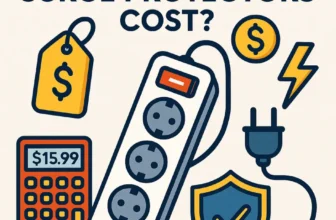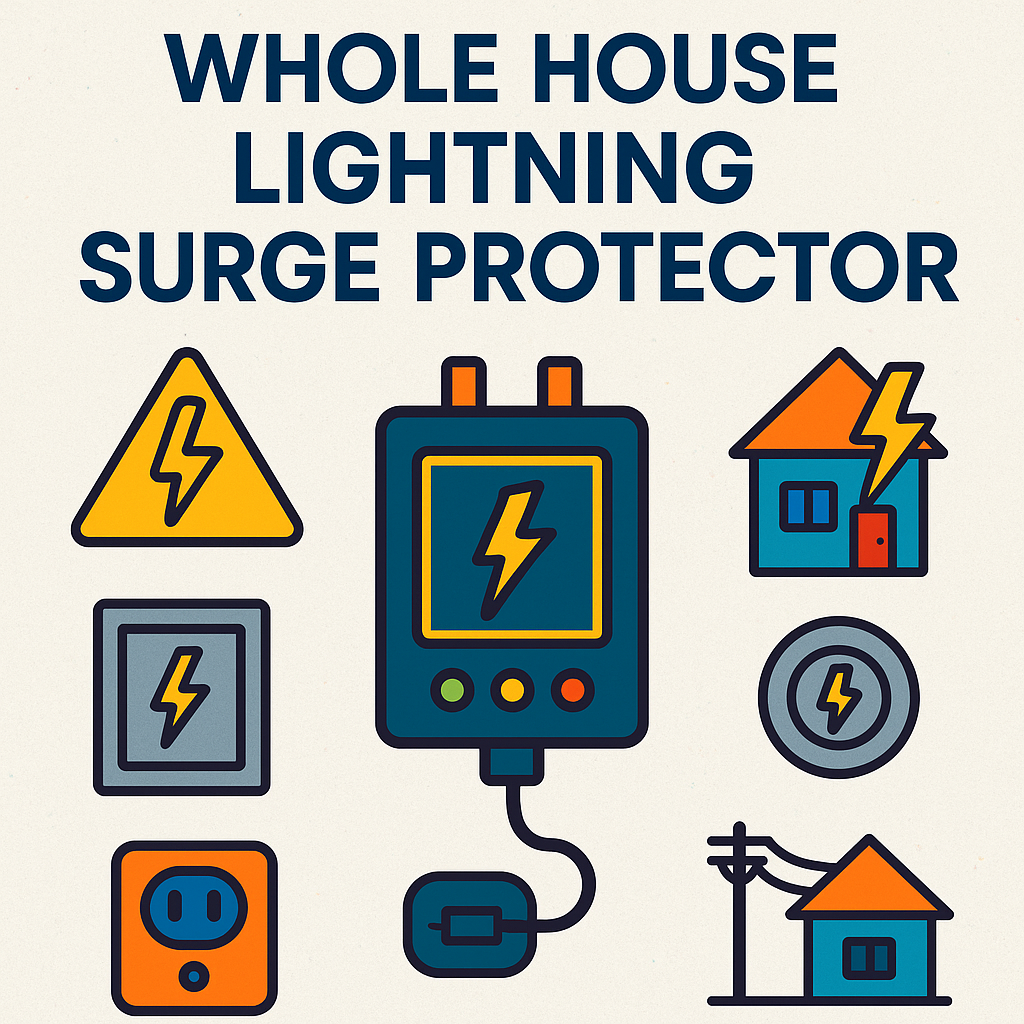Published By: Sean Hudson | Last updated on June 23, 2025 and reviewed by Editorial Team

Effective electrical protection is vital for maintaining the safety and functionality of residential settings. With the increasing reliance on electronic devices and appliances, safeguarding your home against electrical threats is more important than ever. This is where lightning arresters and surge protectors come into play.
A lightning arrester protects your home’s electrical system from external lightning strikes. It diverts the high-voltage surge caused by a direct strike or an induced surge safely into the ground, preventing damage to your infrastructure.
On the other hand, a surge protector shields your electrical appliances from internal voltage spikes, such as those caused by power outages or sudden changes in electricity flow. Surge protectors absorb and dissipate excess voltage, ensuring that your devices remain unharmed during power fluctuations.
Trust me, it is really important that you first understand the differences between a lightning arrester and a surge protector before implementing the right solution in your home. Making an informed choice can help you minimize risks and effectively protect your valuable electronics.
Key Takeaways
- Lightning Protection: Mainly focuses on defending against direct lightning strikes. This includes devices like lightning arresters that divert high voltage surges safely into the ground.
- Surge Protection: Aims to shield against sudden voltage spikes that can come from different sources, such as power outages or small lightning-induced surges. Surge protectors are important for protecting delicate electronic devices.
Practical Steps:
- Install Layers of Defense:
- Start with a whole house surge protector at your main electrical panel.
- Add point-of-use surge protectors for specific appliances.
- Consider Your Environment:
- Evaluate the risk of lightning strikes in your area.
- Ensure outdoor areas and additional buildings are equipped with the proper protection devices.
- Regular Maintenance and Monitoring:
- Check all protection devices regularly for any signs of damage.
- Replace older units to keep them working effectively.
Surge Arrester
Understanding the role of a surge suppressor is key to protecting your home’s electrical systems. These devices are designed to defend against transient voltage and electrical faults, ensuring your appliances are safe from unexpected surges.
Function and Mechanism of Surge Protectors
Surge protectors sometimes referred to as surge suppressors, function by diverting excess voltage away from electrical devices during a surge. They act as a gatekeeper for your home’s electrical system:
- Normal Operation: Under typical conditions, the surge arrester remains inactive, allowing regular voltage to pass through unhindered.
- Voltage Spike: When a spike occurs, the arrester activates, channeling the excess energy safely to the ground.
This mechanism involves components like Metal Oxide Varistors (MOVs) or gas discharge tubes that react quickly to over-voltage conditions.
How Surge Protectors Safeguard Electrical Appliances
Voltage spikes can originate from various sources such as lightning strikes, power outages, or switching operations within the grid. Surge arresters protect your appliances by:
- Absorbing Excess Voltage: The MOVs absorb and dissipate the transient energy.
- Redirecting Surges: They redirect harmful surges away from sensitive electronics to prevent damage.
- Minimizing Downtime: By preventing appliance failure, surge arresters reduce downtime and maintenance costs.
For instance, when a high-voltage spike hits your home’s wiring due to a nearby lightning strike, the surge arrester steps in almost instantaneously. It diverts the spike’s energy away from your expensive home theater system or computer setup.
Common Applications in Residential Electrical Systems
Surge protection devices are versatile and find applications across various points within residential settings:
- Main Service Panels: Typically installed at the main electrical panel to guard against large surges entering from external power lines.
- Sub-Panels: Used in secondary distribution panels to provide localized protection.
- Individual Outlets: Often integrated into power strips for protecting specific high-value electronics like TVs and computers.
Example: You might have a surge protector installed at your main service panel to shield against external surges while using plug-in suppressors for individual devices in your home office. This layered approach ensures comprehensive protection.
Understanding how surge protectors work and their applications will help you make informed decisions about safeguarding your home’s electrical infrastructure.
Lightning Arrester
A lightning arrester (also known as a lightning rod) safeguards your home from the devastating effects of lightning strikes (especially if you stay near lightning-prone areas). It operates by providing a low-resistance path for the electrical energy generated by lightning to travel directly to the ground, thereby preventing it from passing through electrical wiring or appliances in your home.
How Lightning Arresters Work
When lightning strikes an area near your home, the resulting surge can cause significant damage to electrical systems and devices. A lightning arrester works by intercepting this high-voltage surge and safely dissipating it into the earth through a ground wire.
Why You Need Lightning Arresters
Direct lightning strikes pose an obvious threat, but induced surges—caused by a strike occurring near power lines or other structures—can also be hazardous. These surges can travel through power lines and enter your home’s electrical system, potentially causing damage even if the strike doesn’t hit your home directly.
Here’s how lightning arresters protect against both direct lightning strikes and induced surges:
- Direct Strikes: The lightning arrester captures the direct hit and channels the electricity safely into the ground.
- Induced Surges: Even if lightning strikes nearby infrastructure, the arrester mitigates the voltage spike that could otherwise reach your home’s appliances.
Importance of Proper Installation
To ensure optimal performance, installing a lightning arrester correctly is essential. Here are some key guidelines:
- Placement: Install at the highest point of your home, ideally on the roof. This allows it to attract any approaching lightning strike effectively.
- Grounding: Ensure a solid connection to a grounding system. The ground wire should have minimal resistance to allow easy passage of electrical energy into the earth.
- Regular Inspection: Periodically inspect and maintain the system to ensure there are no breaks or corrosion in the wiring.
In most cases, professional installation is recommended to ensure compliance with safety standards and optimal performance.
Lightning arresters provide peace of mind by offering robust protection against both direct hits and induced surges. They play an essential role in any comprehensive electrical protection strategy for residential settings. If you have a solar power system, it’s especially important to consider lightning protection measures as your solar panels can be vulnerable during storms.
Comparing Surge Arresters and Lightning Arresters
It is highly recommended that you understand the differences between a lightning arrester and a surge protector when considering the right protection for your home. Both devices serve to protect against electrical surges, yet they operate in distinct ways and are designed for different purposes.
Similarities: Essential Surge Protection Functions
Both surge arresters and lightning arresters:
- Guard against voltage spikes: They shield electrical systems from sudden increases in voltage that can damage appliances.
- Protect sensitive equipment: Each device helps safeguard valuable electronics from potentially harmful surges.
- Improve safety: By mitigating the risk of electrical fires or failures, these devices enhance overall household safety.
Distinctive Purposes and Working Principles
Surge Protectors
- Function: Designed primarily to protect electrical appliances from transient voltage spikes. These spikes often originate from internal sources, like switching operations or external disturbances such as minor power grid fluctuations.
- Mechanism: Operate by diverting excess voltage away from sensitive electronics to the ground, ensuring a stable power supply to your devices.
- Common Usage: Typically installed in residential settings to guard everyday household appliances, computers, and entertainment systems.
Lightning Arresters
- Function: Specifically engineered to defend against direct lightning strikes and induced surges. These powerful surges can travel through overhead lines or ground paths, causing significant damage.
- Mechanism: Work by capturing lightning energy and channeling it safely into the earth, preventing it from entering the home’s electrical system.
- Common Usage: Often used in conjunction with grounding systems on buildings, particularly in regions prone to frequent thunderstorms.
Key Factors to Consider When Choosing Between the Two
When deciding between a surge suppressor vs lightning arrester, consider:
| Category | Surge Arresters | Lightning Arresters |
|---|---|---|
| Geographical Location | Regions with stable weather but frequent power fluctuations are better suited for surge arresters. | Areas with high lightning activity may benefit more from lightning arresters. |
| Type of Protection Needed | For comprehensive protection against internal surges and minor external disturbances, surge arresters are ideal. | For safeguarding structures against direct lightning impacts, lightning arresters provide robust defense. |
| Installation Requirements | Surge arresters are relatively simple to install within existing electrical panels. | Lightning arresters require proper grounding systems and are often installed externally on buildings. |
Choosing the right protection involves assessing your specific environmental risks and understanding the functionality of each device within your home’s electrical framework.
Best Practices for Comprehensive Home Electrical Protection
The Role of Multiple Layers of Defense: From Main Panels to Individual Appliances
Effective surge protection for homes involves implementing multiple layers of defense. This strategy ensures that different points in your electrical system are safeguarded against voltage spikes and surges:
✅ Main Service Panel Protection: Installing a whole-house surge protector at the main electrical panel is a crucial first step. These devices intercept and divert large surges from external sources such as lightning strikes or utility power issues, preventing them from entering your home’s wiring system.
✅ Point-of-Use Surge Protectors: Adding surge protectors at individual outlets where sensitive electronics are plugged in provides an additional layer of defense. These protectors handle smaller, everyday surges that might bypass the main panel protection.
Combining these methods offers a robust shield against electrical disturbances, ensuring comprehensive coverage for all your appliances and electronics.
Different Types of Surge Protection Devices for Residential Applications
Understanding the variety of available surge protection devices helps tailor the right solution for specific needs. Here are some common types used in residential settings:
| Device Type | Description |
|---|---|
| Whole-House Surge Protectors | Installed at the main service panel, these protect against high-energy surges entering from external sources. They are essential for stopping large voltage spikes before they can distribute throughout the house’s wiring. |
| Power Strips with Built-In Surge Protection | Ideal for home offices or entertainment systems, these strips provide localized protection and are equipped with multiple outlets to safeguard several devices simultaneously. |
| UPS (Uninterruptible Power Supplies) | For critical electronics like computers, combining surge protection with battery backup ensures continued operation during power interruptions, preserving data and preventing damage. |
| Panel-Mounted Surge Protectors | These devices attach directly to specific circuit breakers in your electrical panel, offering targeted protection for high-value or sensitive circuits within your home. |
By employing various surge protection devices strategically throughout your home, you achieve a multi-layered defense that enhances safety and prolongs the lifespan of your electrical installations.
The Importance of Placement and Installation
This section highlights the significance of proper placement and installation for both lightning arresters and surge protectors. Ensuring that these devices are correctly installed plays a crucial role in their effectiveness and the overall protection of electrical systems.
Proper placement and installation help optimize performance and enhance the device’s ability to mitigate electrical surges and protect sensitive equipment.
Distinguishing Outdoor vs Indoor Installation Needs
When it comes to lightning arresters and surge protectors, the installation requirements differ depending on whether they are used outdoors or indoors. Outdoor installations are typically designed to protect against lightning strikes and high voltage surges originating from external sources.
These installations require devices that are specifically designed to withstand harsh weather conditions and direct exposure to lightning strikes.
In contrast, indoor installations primarily focus on safeguarding sensitive electronics from voltage spikes caused by internal sources, such as power outages or faulty wiring. Surge protectors are commonly used for indoor installations to limit the voltage to safe levels and protect devices from damage.
The Impact of Proper Installation on Device Efficiency
Proper installation has a direct impact on the efficiency and performance of lightning arresters and surge protectors. When these devices are installed correctly, they can effectively divert high-voltage surges and limit voltage spikes, thereby protecting electrical systems and equipment.
Poorly installed devices, on the other hand, may not function optimally, resulting in decreased efficiency and reduced protection. Factors such as the choice of mounting location, grounding connections, and adherence to installation guidelines have a significant impact on the device’s overall performance.
It is essential to follow the manufacturer’s recommendations and consult experts to ensure proper installation, thereby maximizing the device’s efficiency in protecting against electrical surges.
Extending the Shield: Safeguarding Against Lightning Damage Beyond the Home
Lightning protection for homes and businesses is not confined to indoor spaces. External structures and systems are equally vulnerable to lightning strikes, which can cause catastrophic damage if left unchecked.
Consider these potential risks:
- Outbuildings: Garages, sheds, and barns often house valuable equipment and tools that require protection.
- Outdoor Areas: Patios, gardens, and pools may have electrical fixtures like lighting or pumps that need safeguarding.
- Commercial Properties: Businesses with outdoor installations such as signage, security systems, or parking lot lighting must ensure these assets are shielded from lightning-induced surges.
To effectively protect external structures, a comprehensive approach incorporating several key measures is essential. Here’s how you can extend the shield beyond your home:
✅ Install Lightning Rods
- These are metal rods placed at the highest points of a structure to attract lightning strikes. They safely direct electrical currents towards the ground through a low-resistance path.
- Example: A barn equipped with a lightning rod system can prevent fire hazards associated with direct strikes.
✅ Implement an Earthing System
- An earthing system (or grounding system) provides a pathway for electrical surges to dissipate into the earth.
- Proper grounding is critical in areas with high soil resistivity. Regular inspections ensure it remains efficient.
- Example: Grounding metallic fences around commercial parking lots reduces the risk of electrical accidents during storms.
✅ Surge Protection Devices (SPDs) for Outdoor Fixtures
- SPDs should be installed on outdoor electrical circuits to protect against voltage spikes caused by nearby lightning strikes.
- Devices such as garden lights, pool pumps, and security cameras benefit significantly from this added layer of defense.
- Example: A surge protector on a pool pump’s circuit can prevent costly repairs due to lightning-induced damage.
✅ Maintenance of Trees and Tall Structures
- Trim trees regularly to avoid them acting as natural conductors that could transfer lightning energy to your home or other structures.
- Ensure tall structures like flagpoles or antennas have proper grounding systems.
- Example: A well-maintained tree line around a commercial property reduces the likelihood of indirect surge paths leading to building damage.
✅ Use of Metal Oxide Varistors (MOVs)
- MOVs are used within surge protectors to absorb excess voltage and safeguard electronic devices.
- They are particularly effective when integrated into SPDs used in external environments.
- Example: Integrating MOVs into outdoor lighting systems can significantly enhance their durability against transient surges.
Understanding these risks and implementing protective measures ensures that both internal and external components of your property remain safeguarded against lightning damage.
Summing Up
Protecting your home against electrical threats, both immediate and indirect, is crucial for keeping your family safe and your appliances in good condition. Knowing the difference between lightning protection and surge protection helps you make smart choices based on what you really need.
Investing in a complete plan that includes both lightning and surge protection methods ensures your home is well-prepared for a wide range of electrical disturbances. When you follow these best practices, you’re building a solid defense system that helps lower risks and boosts the durability of your property’s electrical setup!








